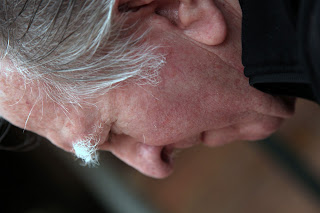 |  |
| In the first half of September, with the advice of the RN, Will, I agreed to Barry being taken to Gosford Hospital to have his stomach pain investigated. This was the very day I forced myself to see my GPO to try to circumvent another round of IV pneumonia treatment. Ross'n'Robyn visited him, and were told that he had urine retention. The low potassium was not discovered until the end of this 5-day stay. He was released back to the faciliuty with a catheter draining his urethra, via his penis, to a bag attached to his leg. He was/is not in the least comfortable with this. Nor does he understand it. Whenever the catheter drains his bladder, he still says he needs to go to the toilet. Yesterday, I was forever asking him whether it was for a wee or a poo. like I was talking to a grand-daughter! He doesn't understand the process, that alone the cause. I tried explaining to him that it is an issue that many men have to contend with as they age. But, new information does not get absorbed by his brain. The facility does not classify him as suffering from dementia, as he has few of the disruptive behaviours. Not that I would wish these upon him. |
 |  |
| So, Friday just gone, Ross'n'Robyn, once again, took Barry to see the urologist in his Gosford rooms. The prostate is enlarged, and there ius total urinary retention. He will be started on potassium tablets which will take about 3 months to kick in. Now comes the bit I am unsure about. There are three treatment possibilities, and I describe them in order of severity: So, there is a lot for me to learn, and to find out. Ross has the urologist's report coming. The urologist recommended that we try them in order, and start with trying to train Barry re his own care. As such, Ross has booked him in for a session at the Erina Continence Clinic. When Baz was cutting his toe-nails yesterday, I noticed the bag on his leg, and asked him to let me have a look. He is used to my blunt ways. The bag was filled to the top, and this was about 10 o'clock in the morning. I know he drinks very little, if any, water. So my guess is that it was not emptied when he woke up. We went and asked an assistant to empty it for him, which happened immediately. But HE did not think to look, nor to ask. This is my concern. |
 |
| Now to the renovation of the facility. It has changed just sooo much in the 2 1/2 years Baz has been a resident. Two-thirds are now "ageing" residents, and one-third is "dementia" residents, in their own gated memory-support unit. Both inside, and the gardens are fully separate. I have gone into my thoughts, and further ideas in a FB post. But here are some of the responses from Barry, and how I am able to use some of the changes to make him feel more at home. In a corridor, not far from his room (4-bed share)), there is a print of Peter Hayward's "The Quiet City" (1960), which shows a street scene in Greenwich Village in Lower Manhatten, New York. We chatted about it, knowing how he would have loved to be a painter. We talked about the stoops, the brownstones, and especially, the flower seller. Now that I know more about it, we will discuss it again next time, and I will get a Sali Herman print of Paddington terraces to compare it with. Then, up too high on the wall, was another print I thought he might like. I took a guess (wrongly, as it turns out) that it was a Tom Roberts or a Frederick McCubbin. Iasked him what he thought the woman was doing. He tried to say a word but could not think of how rto say it. He eventually blurted (yes, quickly) out "beer". Now, I am used to interpreting Juliet;'s 2 YO speech, so I praised him for being so close, and went on to discuss bee-hives, and how the woman did not have any protection from stings. I have one of Alannah;'s book to show him about caring for bees. The print was "The Old Bee Farm" (1900), by Clara Southern. Finally, in an outside sitting area, there was a Japanese metal-craft work, that I knew he would respond to, once again mostly mutely. He could find neither "volcano" nor "Buddha". I discussed the colours, the shape, and the style. Then I went on to a discussion of Buddhism vs Christianity, which he could not engage in at all, except that he knew he was Catholiuc, and that God was more important that Buddha. That is all. After all those years of his like searching, and reaching out, all the angst, and the heartbreak, his main word was "Catholiuc". Drugs are bad shit. |
 |  |













.jpg)
.jpg)

.jpg)


.jpg)






